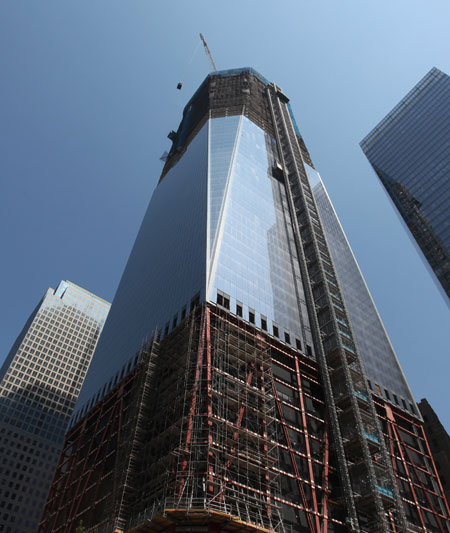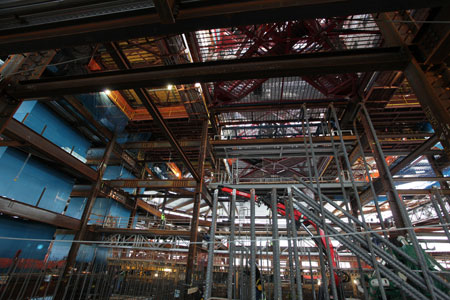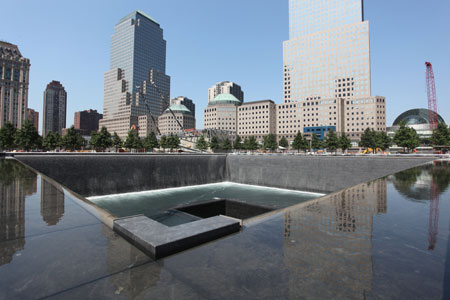
On Sept. 12, when the World Trade Center memorial opens to the public, thousands of people will come to pay their respects amid what is still a massive construction site. Despite a decade’s time and a few billion dollars spent, the place is still crawling with hardhatted workers, spinning cranes, and gaping pits. Even the centerpiece, the Freedom Tower—since renamed One World Trade Center—won’t be done until 2013.
Perhaps because there was so much fighting over its future in the years after the attacks, people assume that things are far behind schedule. On the contrary: Given the enormous architectural, engineering, and bureaucratic challenges that confronted the rebuilding, it’s a miracle that the process is as far along as it is. In fact, Ground Zero is all the better for taking it slow.
The consensus criticism says that the site has long been compromised by politics and greed, so any result is bound to disappoint. There’s no denying that our better angels were lying down on the job when the rebuilding plans were hashed out, roughly between 2002 and 2005. But that doesn’t mean the seemingly slow pace is evidence of failure. At least in part it reflects the unique challenge of the task: Before they could start building, construction crews had to gut the 16-acre “bathtub”—the 60-foot-deep pit that held the underground levels of the original World Trade Center—and reinforce the enormous concrete walls that keep out the Hudson River. Since then the work has been something akin to playing Jenga in reverse, with engineers slowly, precisely adding beams and girders, columns and arches to construct the interlocking spaces and support structures that will become the world beneath the new World Trade Center.
Actually, it’s more like building many Jenga piles in reverse. The project is really multiple different efforts, all connected beneath the surface: the parking and security functions, the 9/11 museum and memorial, the PATH terminal, the subway station, and the subterranean levels of what eventually will be four skyscrapers. From the surface inside the site, one can peer down into the interconnecting structures; when I took a tour recently, my guide, an architect, kept comparing the view to a Piranesi etching. She was right—except that Piranesi’s work is unpopulated, while we saw hundreds of (mostly) men climbing, welding, inspecting, and maneuvering an endless supply of steel down into the depths.
At one point, when we were on a sublevel of the museum, she pointed out a view, 50 feet or so below us, to what will become the rail platforms for the PATH station. Eventually, she said, where we were standing would be a service corridor to an elevator bank, and the view would be blocked by drywall. Thousands of people will pass every day not knowing what is on the other side. And that is one of the beautiful things about the site: When it is finished, none of the engineering will be visible. What seems like ground level will look solid, even though it will be sitting atop six stories of infrastructure. It will be quite a sight not to behold.

Wholly aside from the memorial itself, the engineering genius that went into Ground Zero’s resurrection is a testament to American ingenuity and willingness to cooperate. For all the hemming and hawing about politics and grubby competition early on, it’s a wonder how well all the different firms have worked together. Yes, there was disagreement, and yes, there is still a lot of bureaucracy to be worked out. Then again, it’s not easy to develop an entirely new building type, what the architect Joshua Prince-Ramus calls the “strategostructure”: a megaproject with multiple interlocking functions—museum, office space, memorial, transit—each designed and built by a different team. The teams have significant autonomy, even separate budgets, and yet they are deeply interdependent. The architects designing the memorial and museum pavilion, which sits partly atop the PATH terminal, have to know exactly how much weight the terminal can hold. If the terminal team makes a change in, say, the type of steel used in a load-bearing beam, that decision can ripple through the various projects above and alongside it.
It would have been nice if all that cooperation had begun earlier. But there is a hidden virtue to the waiting. Remember the first years after the attacks, when it seemed like everything at the site would have “freedom” attached to its name—the Freedom Tower, the International Freedom Center, the Freedom Stairs, the Freedom Anti-Skateboard Guard? Or, in 2003 after Daniel Libeskind unveiled his conceptual master plan, how everything had to have symbolic meaning, like some architectonic kabbalah? The Freedom Tower would be 1,776 feet high; if you stood in the right place at the right time on Sept. 11, a “wedge of light” would shine in your face, “in perpetual tribute to altruism and courage” (unless of course it was cloudy outside). That’s all gone.
The Freedom Tower is now, simply, One World Trade Center. The architect in charge, David Childs of Skidmore, Owings, and Merrill, is keeping mum about its ultimate height. The International Freedom Center is a napkin doodle in the dustbin of history. There’s even a movement to move past the name “Ground Zero” and just call it the World Trade Center again—the idea being that Ground Zero, though an apt description in the months after 9/11, is not that great a name for a business district. There’s more than enough symbolism to go around, and none of us needs a hokey “wedge of light” to remind us of what all those police officers and firemen did that day. But like an aging whiskey, it took time for the macho-mystical posturing to filter out. If we could have clicked our heels and seen the plans from 2003 brought to life, would we be happy with what we had?
And while everyone will have their own personal peeves about what we will soon have at the site, overall it’s a fantastic work. Yes, One World Trade Center already looms like Sauron over the hobbits of Lower Manhattan. But the bulk of the original 16 acres has been preserved as open space, which is itself a victory over the forces of Manhattan market capitalism. And Michael Arad’s memorial—two granite-lined voids, which sit in the original towers’ footprints—is much more powerful than I had imagined it would be. Water will flow down the sides of the voids and into smaller holes at their centers. Around their edges run railings etched with the names of the victims.
Some have criticized the design for being overly evocative of the Vietnam veterans’ memorial, with its own inscribed names and granite façade. Those similarities certainly exist. On the other hand, Maya Lin’s memorial has so thoroughly redefined how we memorialize the collective dead that I doubt we would be comfortable with anything more representative or symbolic; in fact, looking at the pedantic, kitschy designs at Oklahoma City and the Pentagon, we usually aren’t. Lin-esque abstraction is so attractive because it speaks to us without lecturing us, a tone we all need to hear at the World Trade Center site. And of course there are differences between Lin and Arad’s memorials, not only in scale and purpose, but in site: Lin’s is in a park stocked with memorials; Arad’s is in the middle of the densest part of the densest city in the country.

And yet his design manages to capture and hold your attention. Standing aside the southern void, I was struck by how large it was, how pure in volume, how fitting for the site and what it represented. Like all great memorials, the voids are many things at once: literal footprints of what used to stand in their place; symbols of loss; aesthetic statements. Thousands of people submitted designs for the memorial, but once you see the voids, you will have a hard time imagining anything else in their place.
How we perceive the memorial will change over time: It will have a different meaning over the next year, when it will be mobbed with tourists, than it will when the gawking stops and solitary visitors can reflect beside the falling water. It will also look much different a decade from now, when the groves of swamp white oak trees, now only saplings, will have matured into leafy, 30-foot giants. Most importantly, we’ll have put distance between us and 9/11. The success of the memorial will lie not in whether we like it or not, but whether it makes a statement that communicates the meaning of that day to future generations. It took a long time to get to the right statement, but on Sept. 12, I believe we’ll have arrived.


